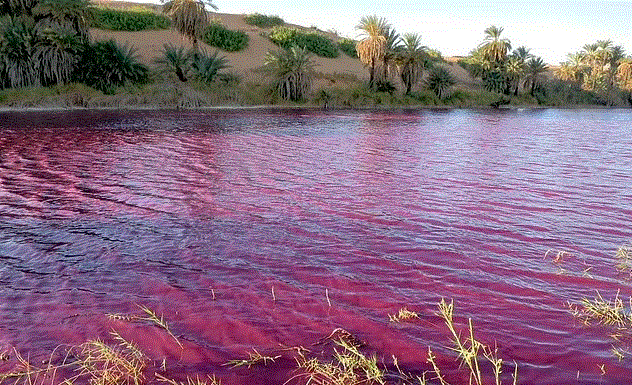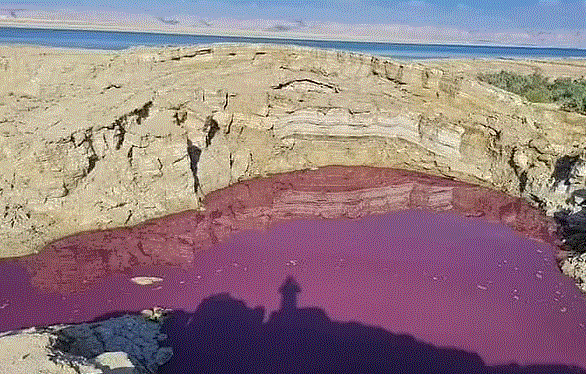
Pool of water located close to the dead sea mysteriously turns BLOOD RED (See Pictures)
Published on September 14, 2021 at 9:45 AM by FACE OF MALAWI
A pool of water located close to the Dead Sea in the biblical region of Moab – modern day Jordan – has mysteriously turned blood red.
Water from the red lagoon just inside the Jordanian border is being sampled by workers from Jordan’s Ministry of Water and Irrigation to determine the cause of the unsettling phenomenon which is as yet unexplained.
The images have sparked a furore on social media, with blood red waters carrying much significance in the Old Testament as one of the 10 plagues God cast upon the Pharaoh of Egypt to free the Jews from slavery.
According to the biblical tale, God turned the waters of the River Nile into blood, which killed the fish and prevented the Egyptians from drinking the foul water, in the first of 10 plagues that came as the Pharaoh’s punishment for refusing to free his Jewish slaves.
The eastern shores of the Dead Sea where the blood red pond is located also happens to be where the two legendary cities of Sodom and Gomorrah stood before they were supposedly destroyed by God for their ‘wickedness’.
The head of the Water and Agriculture Committee of the Al-Karak Council, Fathi Al-Huwaimel, said that the authorities have been contacted to work on identifying the source of the water.

But although the cause of the mysterious crimson waters remains unknown for now according to Jordan’s ministry spokesperson Omar Salameh, a few theories have been posited as to why a lagoon isolated from fresh water could suddenly change colour.
Director of Agriculture in the Southern Jordan Valley, Yassin al-Kasasbeh, told Roya News that this phenomenon is found in ponds close to seas due to the presence of a certain type of a bacteria and red algae that love salinity, which changes its colour with the presence of sunlight.
But this does not explain why the water suddenly turned red while other pools have not displayed the same phenomenon, particularly given that the region experiences near year-round sunny skies.
Other officials told Israel Today that the presence of iron oxide in the water could account for the strange colour change, but again did not give an explanation as to how the iron oxide would have been introduced to the pool, and why the colour change happened so rapidly.
Meanwhile, Sakhr Al-Nusour, the head of the Jordanian Geologists Syndicate, told the Al Ghad news that the red colour could have been caused by the addition of substances by humans.
This viewpoint was shared by many Jordanians who accused the government of covering up a source of pollution or their use of the pool as a dumping ground for waste chemicals.
The Dead Sea is a salt lake located in the Judean desert of southern Israel, bordered by Jordan to the East.
With its origin dating back to some four million years ago, it is one of earth’s saltiest bodies of water and is the lowest point on earth.
Its high level of salinity – well over 30% – means its waters are incredibly rich in minerals and the health benefits of bathing in the Dead Sea have long been touted, though it is so salty that the water cannot support marine life.
It has been found that people with respiratory diseases, such as cystic fibrosis, have appeared to benefit from increased atmospheric pressure in the region, while the temperature, humidity and water’s minerals make it a perfect environment to treat skin problems.
It’s also been suggested that Dead Sea mud pack therapy relieves pain in patients with osteoarthritis of the knees.
However, the Dead Sea has shrank dramatically in recent years, most likely due to climate change.
It is now roughly 31 miles long and 9 miles wide at its widest point, but it is estimated that the Dead Sea’s water level has dropped by more than 131ft since the 1950s, and is now reducing by around two ft per year.
Last year, the Alexander River ran blood-red due to blood from slaughterhouses in the West Bank flowing into the river, according to the Society for the Protection of Nature in Israel.
HISTORY OF THE DEAD SEA
The Dead Sea carries considerable biblical and religious significance.
During the Biblical period, different sects of Jews used to live in caves near the Dead Sea, most notably the Essesnes, who are thought to have left the impressive Dead Sea Scrolls in the caves of Qumran.
The scrolls are a collection of more than 25,000 ancient manuscript fragments, among which can be found the oldest known copies of books of the Hebrew Bible.
They were first found in the Qumran Caves near the Dead Sea in 1946 and their discovery was described by biologist Oded Rechavi of Israel’s Tel Aviv University as ‘one of the most important archaeological discoveries ever made’.
The scrolls are now being painstakingly pieced back together by archaeologists.
Sodom and Gomorrah, the famous cities mentioned in the Book of Genesis, are believed to have been on the Dead Sea’s southeastern shore, while Ein Gedi, now a nature reserve near the Dead Sea, is mentioned in the Bible as the place where King David – the man who famously killed Goliath – hid from Saul.
Meanwhile, in the modern era, scientists from Israel and Germany discovered in 2011 that the floor of the Dead Sea contains fissures which allow fresh water to bubble up from below the sea bed.
Despite the water’s salinity making the environment inhospitable to marine life, many species of bacteria and archaea live on the sea floor and feed off the minerals that rise up through the fissures, while the area’s atmospheric pressure, warmth and mineral rich water makes it a go-to destination with mythical healing qualities.
Source:DailyMail


